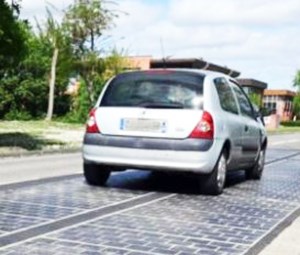Gloomy Results for French Solar Road
The 1-km (0.6-mile) solar road installed in late 2016 in northwest France has failed to meet expectations for the project, reports Le Monde.
The 1-km (0.6-mile) solar road installed in late 2016 in northwest France has failed to meet expectations for the project, reports Le Monde.
Located in Normandy near the village of Tourouvre-au-Perche, the so-called Wattway was expected to generate enough electricity to power public lighting for a city with 5,000 residents. But critics say the road is inefficient, noisy and falling apart.

Constructed by Colas Group, the Wattway consists of 2,800 photovoltaic panels laid on top of an existing road. The French government invested €5 million ($5.5 million) in the project, which eventually was to span 620 miles.
Last year, the Wattway generated just 80,000 kWh, a little more than half of its expected 150,000-kWh output. The shortage is attributed in part to the road’s location—Normandy typically has only 44 days of strong sunshine per year, and severe rainstorms have temporarily short circuited the panels.
Solar panels positioned on a flat road also are inherently less efficient than panels mounted on building roofs angled toward the sun, Le Monde notes. Leaves, other debris and passing vehicles also can block the sun’s rays to further reduce their efficiency.
Colas’ originally claimed that the panels would last 10 years and accommodate commercial trucks. But heavy farm tractors have caused tattered joints and shredded off some of the panels’ protective resin coating. As much as one-tenth of the road already is deemed to be too damaged to repair.
Following noise complaints from nearby residents, authorities lowered the speed limits on the road to 70 kph (43 mph), according to the newspaper.
Etienne Gaudin, who heads the Wattway program for Colas, concedes that the technology is “not mature for inter-urban traffic.” In addition to the Normandy program, Colas is testing the Wattway technology on 40 smaller road sections throughout France and other areas. Other companies are developing similar systems.
RELATED CONTENT
-
Increasing Use of Structural Adhesives in Automotive
Can you glue a car together? Frank Billotto of DuPont Transportation & Industrial discusses the major role structural adhesives can play in vehicle assembly.
-
On Fuel Cells, Battery Enclosures, and Lucid Air
A skateboard for fuel cells, building a better battery enclosure, what ADAS does, a big engine for boats, the curious case of lean production, what drivers think, and why Lucid is remarkable
-
Jeeps Modified for Moab
On Easter morning in Moab, Utah, when the population of that exceedingly-hard-to-get-to town in one of the most beautiful settings on Earth has more than doubled, some people won’t be hunting for Easter eggs, but will be trying to get a good look at one of the vehicles six that Jeep has prepared for real-life, fast-feedback from the assembled at the annual Easter Jeep Safari.








